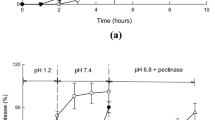Abstract
Purpose. The aim of the present study was to provide 'proof of concept' data in man for novel polysaccharide preparations designed for colonic drug delivery using gamma scintigraphy.
Methods. Two placebo calcium pectinate matrix tablet formulations were studied: one contained calcium pectinate and pectin (CaP/P) and was designed to rapidly disintegrate in the ascending colon, the other contained calcium pectinate and guar gum (CaP/GG) and was designed to disintegrate more slowly, releasing its contents throughout the ascending and transverse colon. Both formulations were enteric coated in order to protect them from the stomach. Ten healthy volunteers received either a CaP/P or CaP/GG tablet, in a randomised cross-over study. Transit and disintegration of the radiolabelled formulations was followed by gamma scintigraphy. Rat studies were conducted in order to verify that the expected colonic degradation of the polysaccharide formulations was as a consequence of bacterial enzyme attack.
Results. Thein vivo clinical study confirmed the results obtained in the rat and bench in vitro fermentation models; complete tablet disintegration for Formulation CaP/GG appeared to be slower than that of Formulation CaP/P and the time and the location of complete tablet disintegration was more reproducible with Formulation CaP/P compared to Formulation CaP/GG.
Conclusions. These results provide 'proof of concept' data for the use of calcium pectinate preparations for drug delivery to the colon and highlight the value of scintigraphy in focusing the development strategy for colonic targeting preparations.
Similar content being viewed by others
REFERENCES
A. Rubinstein, Crit. Rev. Ther. Drug Carr. Sys., 12:101–149 (1995).
V. H. L. Lee. Pharm. Tech. Int. 10:59–62 (1992).
P. Gruber, M. A. Longer, and J. R. Robinson. Adv. Drug De. Rev. 1:1–18 (1987).
W. A. Ritschel. Methods Find. Exp. Clin. Pharmacol. 13:313–336 (1991).
M. J. Dew, P. J. Hughes, M. G. Lee, B. K. Evans, and J. Rhodes. Br. J. Pharmacol. 14:405–408 (1982).
M. Saffran, G. S. Kumar, C. Savariar, D. C. Neckers, J. Pena, R. H. Jones, and J. B. Field. Biochem. Soc. Trans. 18:752–754 (1990).
D. R. Friend and G. W. Chang. J. Med. Chem. 27:261–266 (1984).
A. Rubinstein, D. Nakar, and A. Sintov. Pharm. Res. 9:276–278 (1992).
A. Rubinstein, R. Radai, M. Ezra, S. Pathak, and J. S. Rokea. Pharm. Res. 10:258–263 (1993).
M. Ashford, J. T. Fell, D. Attwood, H. Sharma, and P. J. Wood. J. Cont. Rel. 30:225–232 (1994).
H. N. Englyst, S. Hay, and G. T. Macfarlane. FEMS Microbiol. Ecol. 95:163–171 (1987).
I. R. Wilding. STP Pharma. Sci. 5:13–18 (1995).
I. R. Wilding, A. J. Coupe, and S. S. Davis. Adv. Drug Del. Rev. 7:87–117 (1991).
G. T. Macfarlane, S. Hay, S. Macfarlane, and G. R. Gibson. Appl. Bacteriol. 68:179–187 (1990).
J. Kopecek, P. Kopeckova, H. Brondsted, R. Rathi, R. Rihova, P.-Y. Yeh, and K. Ikesue. J. Contr. Rel. 19:121–130, (1992).
D. A. Adkin, S. S. Davis, R. A. Sparrow, and I. R. Wilding. J. Contr. Rel. 23:147–156 (1993).
G. Hawksworth, B. S. Drasar, and M. J. Hill. J. Med. Microbiol., 4:451 (1971).
S. S. Davis, J. G. Hardy, and J. W. Fara. Gut 27:886–892 (1986).
A. Rubinstein and I. Gliko-Kabir. S.T.P. Pharma. Sci. 5:41–46 (1995).
Author information
Authors and Affiliations
Rights and permissions
About this article
Cite this article
Adkin, D.A., Kenyon, C.J., Lerner, E.I. et al. The Use of Scintigraphy to Provide 'Proof of Concept' for Novel Polysaccharide Preparations Designed for Colonic Drug Delivery. Pharm Res 14, 103–107 (1997). https://doi.org/10.1023/A:1012019820603
Issue Date:
DOI: https://doi.org/10.1023/A:1012019820603




